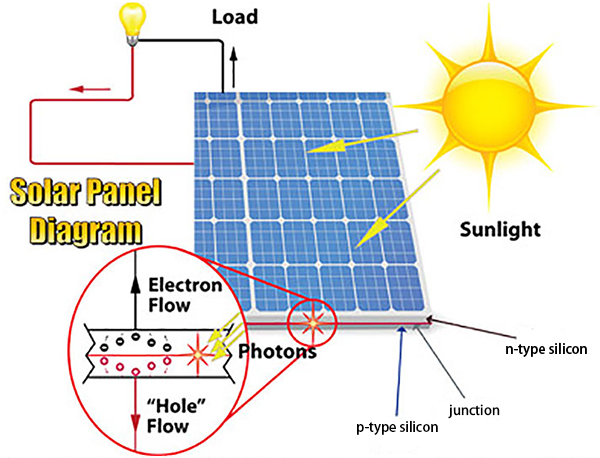The sun is an unlimited source of energy, scientists describe it as a natural nuclear reactor. Solar energy can be converted into various kinds of energy, such as thermal energy, electrical energy, chemical energy so on. Which are essential to our lives, and we cannot live without them.Solar panels are an important solar power generation tool with a wide range of uses. Understanding the working principle and importance of solar panels will help us better learn to use solar tools and facilitate our daily lives.
How does the solar panel work?
- Photovoltaic Cells: Solar power panels are made up of many small units called photovoltaic (PV) cells. Each PV cell is made of semiconductor materials, usually silicon, which has the ability to absorb light.
- Absorption of Sunlight: When sunlight hits the surface of a solar panel, energy from the sunlight (photons) is absorbed by the semiconductor material.
- Generation of Electron-Hole Pairs: The energy from the absorbed photons excites electrons in the semiconductor, causing them to break free from their atoms. This creates electron-hole pairs (an electron is negatively charged, and the hole is the absence of an electron, which can act as a positive charge).
- Creation of Electric Field: The solar cell has an electric field due to the junction between two layers of semiconductor materials (usually p-type and n-type silicon). This electric field pushes the free electrons toward the n-type layer and the holes toward the p-type layer.
- Electric Current Generation: The movement of these electrons generates a flow of electric current. Metal contacts on the top and bottom of the solar cell collect these free electrons, allowing the current to flow out of the panel.
- Direct Current (DC) Power: The current produced by the solar panel is direct current (DC). However, most home appliances use alternating current (AC). To convert the DC to AC, an inverter is used.
As mentioned, the number of solar cells connected will form the solar power panel power inverter (called module as well). Also, connecting several solar panels in series with each other will form a solar string, and then connecting the number of solar stings in parallel will form the solar array which represents the final solar panel's system. So, the more solar panels we use, the larger the solar array we get, and of course, the higher electrical energy we can get from the solar system.
The importance of solar panels
- Environmental protection and energy saving: Solar panels absorb sunlight and convert it into electrical energy. No pollutants are produced in the process. It is a truly green energy. Using solar panels can effectively reduce carbon emissions and help achieve global climate goals
- Sustainable supply: Solar energy is an inexhaustible energy source. As long as the sun continues to exist, solar energy can be continuously supplied
- Affordable: Although the initial installation cost of solar panels is high, the long-term benefits are very considerable. Through the model of self-generation and self-use, and the surplus power is connected to the grid, users can significantly reduce electricity bills and even earn extra income by selling electricity
- Stable and reliable: Modern photovoltaic technology is very mature, the life of solar panels is usually more than 25 years, and the maintenance cost is extremely low. As long as the surface of the panel is cleaned regularly to ensure that it fully absorbs sunlight, stable power generation efficiency can be guaranteed
